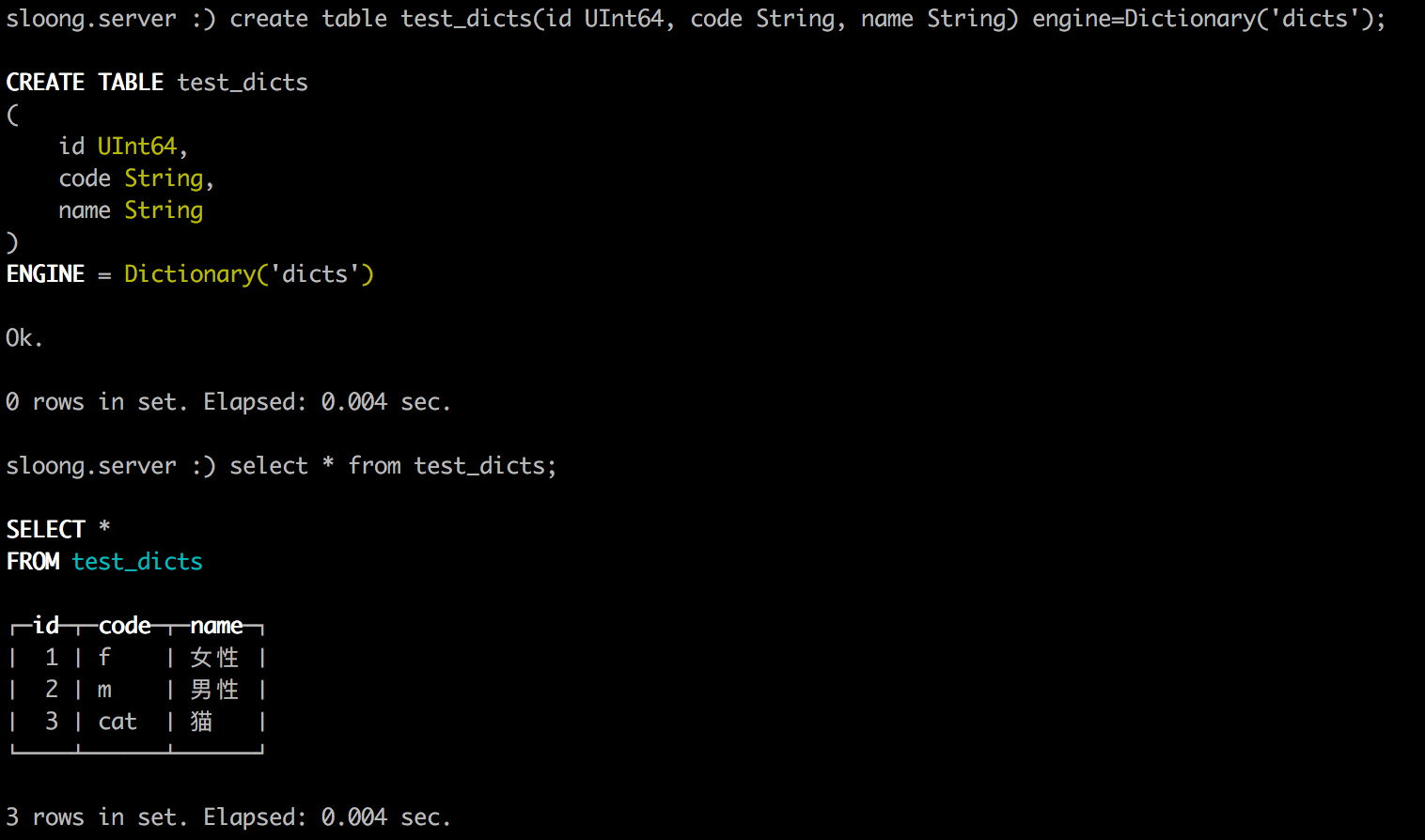Clickhouse Dictionaries 字典使用
clickhouse支持从各种数据源添加自己的字典。字典的数据源可以是本地文本、可执行文件
、HTTP(s)资源或其他DBMS。有关更多信息,请参阅“外部词典的来源”。
- 完全或部分将字典存储在RAM中。
- 定期更新字典并动态加载缺失值。换句话说,可以动态加载字典。
外部词典的配置位于一个或多个文件中。 配置的路径在dictionaries_config参数中指定。
字典配置:
*_dictionary.xml
当前配置文件目录下,以_dictionary.xml结尾的均作为字典配置文件进行字典加载。
字典可以在服务器启动时或首次使用时加载,具体取决于dictionaries_lazy_load设置。
字典懒加载
true
如果设置为true, 每个字典只在第一次使用时创建. 如果字典创建失败,则会在调用字典函数时抛出异常.
如果设置为false,所有字典则会在服务器启动时加载,如果加载过程中有异常,则会shutdown 服务。
以mysql为例,尝试下Clickhouse的字典功能。最后的配置附录中包括:
- 以 flat形式存储的Numeric keyKey类型的字典
- 以 complex_key_hashed形式存储的Composite keyKey类型的字典
建立外部字典
MYSQL 中建立测试表test_dict,并添加3条记录
```sql SET NAMES utf8mb4; SET FOREIGN_KEY_CHECKS = 0;
— Table structure for test_dict
DROP TABLE IF EXISTS test_dict;
CREATE TABLE test_dict (
id int(11) NOT NULL,
code varchar(20) NOT NULL,
name varchar(200) DEFAULT NULL,
status tinyint(4) NOT NULL DEFAULT ‘1’,
PRIMARY KEY (id) USING BTREE
) ENGINE=InnoDB DEFAULT CHARSET=utf8;
— Records of test_dict
BEGIN;
INSERT INTO test_dict VALUES (1, ‘f’, ‘女性’, 1);
INSERT INTO test_dict VALUES (2, ‘m’, ‘男性’, 1);
INSERT INTO test_dict VALUES (3, ‘cat’, ‘猫’, 1);
COMMIT;
SET FOREIGN_KEY_CHECKS = 1;
<a name="IFa9E"></a>#### 在clickhouse 配置文件目录建立字典配置文件> vi tmysql_dictionary.xml`tmysql_dictionary.xml`内容如下:```xml<dictionaries><dictionary><name>dicts</name><!--字典名称--><source><mysql><!--dbms类型:mysql--><replica><!--mysql 服务器,多台/主从可以配置多个--><host>116.255.199.xx</host><priority>1</priority><!--优先级--></replica><port>3306</port><!--端口--><user>xxxx</user><!--mysql用户名--><password>xxxxx</password><!--mysql 密码--><db>db_benchmark</db><!--数据库--><table>test_dict</table><!--表--><where>status=1</where><!--过滤条件--><invalidate_query>select count(*) from test_dict where status=1</invalidate_query><!--如果该查询结果发生变更,则更新字典--></mysql></source><lifetime><!--clickhouse 会在这个时间间隔范围内,随机均匀时间进行字典升级(负载均衡),避免大量同时升级字典源--><min>300</min><max>360</max></lifetime><layout><!--字典在内存中存储方式;flat:二维数组(flat arrays),其他类型见文档--><flat/></layout><structure><id><name>id</name><!--主键,好像必须是正整数型(UInt64)--></id><attribute><!--其他属性--><name>code</name><!--属性名称--><type>String</type><!--属性类型--><null_value></null_value><!--null值替换--></attribute><attribute><name>name</name><type>String</type><null_value></null_value></attribute></structure></dictionary></dictionaries>
重新启动clickhouse服务,测试
clickhouse-server –config-file=/etc/clickhouse-server/config.xml clickhouse-client -m
select * from system.dictionaries where name =’dicts’;
字典的使用
字典函数
具体函数见:ext_dict_functions
当需要对字典使用原始数据或者执行join操作时,则可以使用Dictionary engine建立字典视图
创建字典视图语法:
CREATETABLE %table_name% (%fields%) engine = Dictionary(%dictionary_name%)`
create table test_dicts(id UInt64,code String,name String)engine=Dictionary('dicts');select * from test_dicts;
配置文件附录
- 以 flat形式存储的Numeric key型的字典
- 以 complex_key_hashed形式存储的Composite keyKey类型的字典
vim tmysql_dictionary.xml
<dictionaries><dictionary><name>dicts</name><source><mysql><replica><host>116.255.199.xx</host><priority>1</priority></replica><port>3306</port><user>db_benchmark</user><password>password</password><db>db_benchmark</db><table>test_dict</table><where>status=1</where><invalidate_query>select count(*) from test_dict where status=1</invalidate_query></mysql></source><lifetime><min>300</min><max>360</max></lifetime><layout><flat/></layout><structure><id><name>id</name></id><attribute><name>code</name><type>String</type><null_value></null_value></attribute><attribute><name>name</name><type>String</type><null_value></null_value></attribute></structure></dictionary><dictionary><name>mydicts</name><source><mysql><replica><host>116.255.199.xx</host><priority>1</priority></replica><port>3306</port><user>db_benchmark</user><password>password</password><db>db_benchmark</db><table>test_complex_key_dict</table><where></where><invalidate_query>select count(*) from test_complex_key_dict</invalidate_query></mysql></source><lifetime><min>100</min><max>160</max></lifetime><layout><complex_key_hashed /></layout><structure><key><attribute><name>code</name><type>String</type></attribute></key><attribute><name>value</name><type>String</type><null_value>??</null_value></attribute></structure></dictionary></dictionaries>


